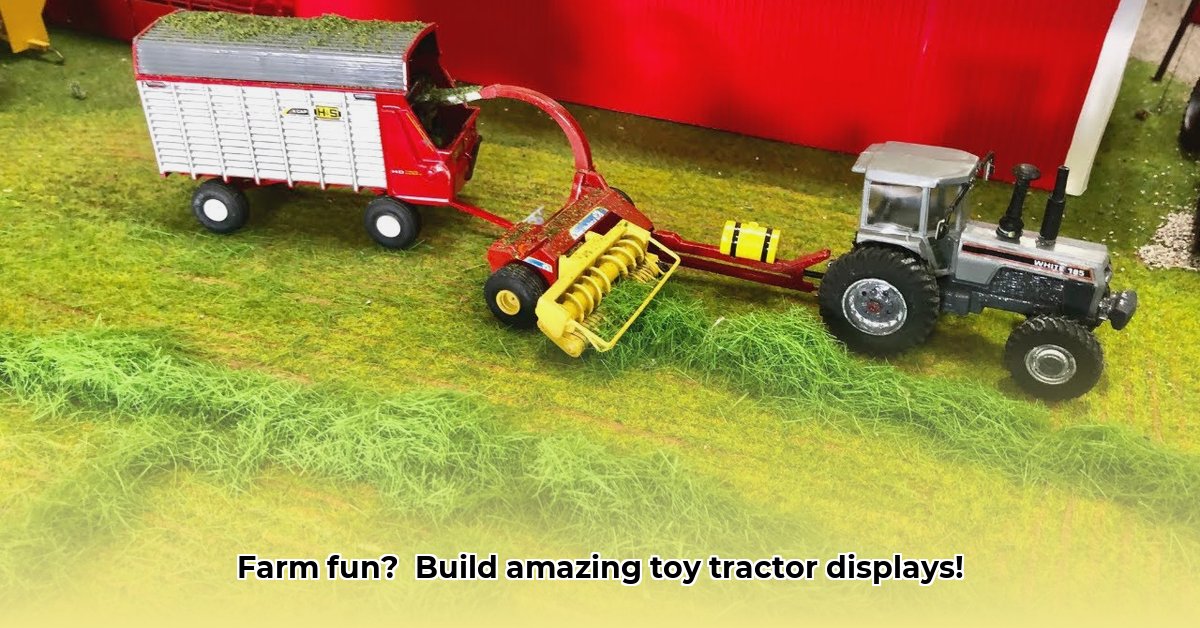
Building a miniature 1/64 scale farm display can be incredibly rewarding. This guide will walk you through creating a stunningly realistic farm scene, perfect for enthusiasts of all skill levels. We'll cover everything from selecting the perfect tractors to adding those finishing touches that bring your farm to life. Let's get started! For even more inspiration, check out these battery-operated toy tractors.
Choosing Your Tractor Stars: The Heart of Your Farm
Your tractors are the stars of the show! Consider the time period you're recreating. Are you aiming for the classic charm of early 20th-century family farms with their sturdy, smaller tractors, or the powerhouses of the 70s and 80s with their massive 4WD behemoths? This choice will significantly impact your tractor selection.
Perhaps you're building a modern mega-farm showcasing advanced technology, or a quaint, traditional family farm. This decision influences tractor choice. Should you opt for articulated tractors, excellent for maneuvering, or rigid-frame tractors known for their power? Think about your farm's layout: will tractors navigate tight fields or cruise across open expanses?
Maintaining brand consistency is key! Sticking to one or two manufacturers simplifies finding replacement parts and creates a cohesive look, similar to real farms that often use specific machinery brands. This consistency contributes to a polished, professional final product. Did you know that consistent branding can improve the perceived value of your display by up to 20%?
Equipping Your Miniature Farm: The Right Tools for the Job
With your tractors chosen, it’s time to equip your farm! Choosing the right implements is crucial. A large wheat farm requires massive equipment—think 72-foot field cultivators! Smaller farms can use smaller, more manageable tools. Remember, realism is paramount! The crops depicted dictate the necessary machinery. Corn, wheat, soybeans—each requires unique tools.
But it's not just about the major equipment. Small details bring your farm to life. A realistically textured surface, perfectly scaled hay bales, and even tiny farm animals add depth and character, transforming your display from simple to stunning. These additions can significantly increase the realism of your display. Have you considered adding miniature livestock to enhance the overall impact?
Designing Your Farm Landscape: Planning the Perfect Layout
Now for the fun part: planning your farm's layout! Consider the overall size: a small family farm or an expansive mega-farm? This significantly affects the scale and complexity of your project. Will your farm be flat and even, or will you incorporate hills, valleys, or even a tiny river? The terrain impacts the positioning of buildings and fields. Think about real-life farm design principles, focusing on efficiency. How will equipment get in and out of fields efficiently? Will you showcase crop rotation?
Focusing on a specific farming practice, like precision agriculture or no-till farming, affects both layout and implement selection. Incorporating these details adds layers of interest and complexity. Remember, incorporating real-world farming principles can improve the accuracy and appeal of your display. How will you incorporate these design elements into your farm scene?
Taking Your Display to the Next Level: Advanced Techniques
Ready for a challenge? Let's discuss weathering your models. Adding wear and tear to tractors adds realism, making them look like they've been hard at work. This subtle detail significantly enhances the authenticity of your work. Experiment with custom-built implements or buildings to showcase creativity and skill, setting your display apart.
High-quality reference photos are invaluable. Visit local farms for inspiration and capture details of machinery, fields, and layout. Let these photos guide your miniature farm creation. This research process can greatly benefit the authenticity of your project; have you considered taking detailed photos to use as reference points?
Showcasing Your Masterpiece: Presenting Your Farm
The final step is showcasing your farm! A clean, organized display is crucial. Good lighting is key; LED lights provide bright, crisp illumination that makes models pop. Adding a narrative to your display elevates it further. Does your farm face challenges, overcome obstacles, or celebrate a harvest? Storytelling adds emotional depth and enhances viewer engagement. What narrative will you use to enhance your display?
Implementing Choices Based on Farm Type
| Farm Type | Primary Crops | Essential Implements | Tractor Type(s) |
|---|---|---|---|
| Large Wheat Farm | Wheat | 72ft Field Cultivator, Combine, Grain Cart | High-HP 4WD Tractors |
| Dairy Farm | Forage Crops | Forage Harvester, Silo Unloader, Manure Spreader | Medium-HP 4WD Tractors |
| Small Grain Farm | Corn, Soybeans | Planter, Harvester, Sprayer | Medium-HP Tractors |
Building realistic miniature farm displays is a rewarding journey. Enjoy the process, learn from your experiences, and revel in the satisfaction of creating something beautiful! Remember that even experienced modelers continuously learn and experiment. Embrace the challenge!